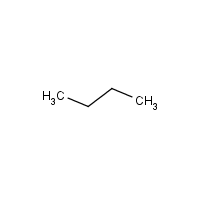n-Butane
Agent Name
n-Butane
Alternative Name
Butane
CAS Number
106-97-8
Formula
C4-H10
Major Category
Solvents

Synonyms
normal-Butane; Butyl hydride; Diethyl; Methylethylmethane; Butane; Note: Also see specific listing for Isobutane; [NIOSH] UN1011
Category
Aliphatics, Saturated (<C12)
Description
Colorless gas with a gasoline-like or natural gas odor; Note: Shipped as a liquefied compressed gas. A liquid below 31 degrees F; [NIOSH] Vapor density = 2.07 (heavier than air); [HSDB]
Sources/Uses
Used as an aerosol propellant, fuel, and chemical intermediate; present in natural gas and liquefied petroleum gas (LPG); [ACGIH]
Comments
Possible frostbite from contact with liquid; [NIOSH] "TLV Basis" is CNS impairment; Caused drowsiness in 6 men and 6 women after exposure to 1% (10,000 ppm) for 10 minutes; "The median effective concentration (EC50) for producing cardiac sensitization in anesthetized dogs was 7% (70,000 ppm)." No symptoms in 53 refinery workers exposed to 1 to 8 ppm for 11 years; Deaths in butane gas abusers were attributed to hypoxia and cardiac failure. [ACGIH: Butane, isomers] A chemical abused by inhaling (lighter fluid); may be abused by teenagers because it is cheap and available; Butane is in the list of "Some volatile substances which may be abused by inhalation" published on the web site of the U.N. International Drug Control Programme, indicating its potential to cause narcosis in workers. [Reference #1] In confined space spill, may displace air and act as simple asphyxiant; Inhalation of high concentrations may cause CNS effects; [ICSC]
Reference Link #1
Biomedical References
Exposure Assessment
Skin Designation (ACGIH)
Insufficient data
STEL (ACGIH)
1000 ppm
MAK
1000 ppm
IDLH (NIOSH)
1600 ppm
Odor Threshold Low
1.2 ppm
Odor Threshold High
6.5 ppm
Lethal Concentration
LC50 (rat) = 658,000 mg/m3
Explanatory Notes
Odor threshold from ACGIH; Flash point = -60 deg C; "Explosion Hazard." [TLVs and BEIs]
Reference Link #2
NFPA
burn readily
Adverse Effects
Neurotoxin
Acute solvent syndrome
Other Poison
Simple Asphyxiant
Diseases, Processes, and Activities Linked to This Agent
Diseases
Occupational diseases associated with exposure to this agent:
Processes
Industrial Processes with risk of exposure: